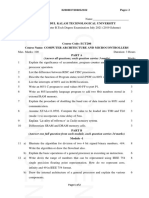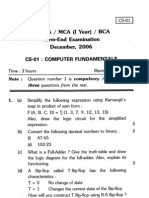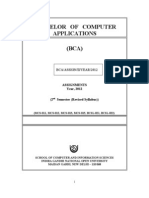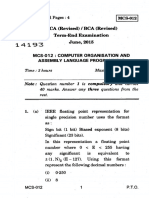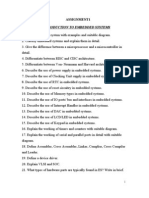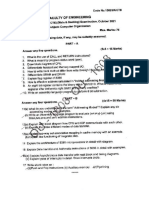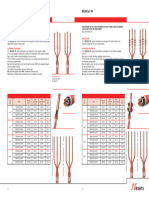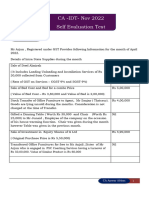CS-01 Computer Fundamentals
Uploaded by
dhritimohanCS-01 Computer Fundamentals
Uploaded by
dhritimohanNo.
of Printed Pages : 3
CS-01(
PGDCA/MCA (I YEAR)/BCA Term-End Examination December, 2011 c\i
O CS-01 : COMPUTER FUNDAMENTALS O
Time : 3 hours
Note :
Maximum Marks : 75
Question number 1 is compulsory and carries 30 marks. Answer any three questions from the rest.
1. (a) Make the truth table for the following 5
boolean function : F(A, B, C, D)=A'B+B'C+C'D Simplify the function above using Karnaugh's map. Draw. the resultant logic diagram. Using AND, OR and NOT gates. (Please note A' represents complement of A). (b) Explain with the help of an example how 5 number of addresses in an instruction changes the size of a program. (c) Write a program in 8086 assembly language 6 programming that counts the number of characters in a given string. You may
CS-01
P.T.O.
assume that the string is stored in the consecutive memory locations and is terminated by a $ character. (d) What is instruction pipelining ? How is it implemented in RISC machine ? Explain with the help of a diagram. (e) Define the following terms in the context of computer organisation : (i) (ii) (iii) (iv) Interrupt driven Input/Output Associative memory Register indirect addressing Flag register
2. (a) Explain the floating point representation with the help of any example using 32 bit representation. (b) (c) Explain the functioning of master - slave flip - flop using a suitable diagram. List three uses of INT 21h in 8086 assembly language programs.
3. (a) What is vector computation ? Explain with the help of an example. (b) Explain the basic structure of a control unit with the help of a diagram. CS-01 2
(c) Write a program using 8086 assembly 6 language that converts two ASCII digits stored in consecutive memory location to a packed BCD number. The resultant BCD number is left in AL register. 4. (a) What is the need of memory hierarchy ? 5 Explain the terms seek time and rotational (b) Explain the following addressing modes 5 with the help of an example each : (i) Displacement addressing using base register. Stack addressing. (c) Explain the multiport memory organisation 5 for multiprocessor as system with the help of a diagram. 5. Explain the following with the help of an 15 example/diagram, if needed : (a) Micro - instruction (b) (c) (d) (e) Fetch Cycle Subroutine call DRAM Advantages of Integrated Circuits (ii) latency in the context of a magnetic disk.
CS-01
You might also like
- Víctor Olaya - ''A Gentle Introduction To SAGA GIS (Edition 1.1) ''No ratings yetVíctor Olaya - ''A Gentle Introduction To SAGA GIS (Edition 1.1) ''217 pages
- George Bayer-Turning 400 Years of Astrology To Practical Use & Other Matters (1969) PDF75% (4)George Bayer-Turning 400 Years of Astrology To Practical Use & Other Matters (1969) PDF194 pages
- Ect206 Computer Architecture and Microcontrollers, July 2021No ratings yetEct206 Computer Architecture and Microcontrollers, July 20212 pages
- Non-Restoring Division. (8) : A B+ C G HNo ratings yetNon-Restoring Division. (8) : A B+ C G H2 pages
- CRC of BCA (2) Assignment (Revised Syllabus)No ratings yetCRC of BCA (2) Assignment (Revised Syllabus)17 pages
- Computer Organisation and Assembly Language ProgrammingNo ratings yetComputer Organisation and Assembly Language Programming4 pages
- MCA (Revised) Term-End Examination - Une, 2409No ratings yetMCA (Revised) Term-End Examination - Une, 24094 pages
- Unit I - Introduction To Embedded Systems: Assignment1No ratings yetUnit I - Introduction To Embedded Systems: Assignment112 pages
- ECT206 COMPUTER ARCHITECTURE AND MICROCONTROLLERS, JUNE 2023No ratings yetECT206 COMPUTER ARCHITECTURE AND MICROCONTROLLERS, JUNE 20232 pages
- Group A: SUMMER 2005 Computing and InformaticsNo ratings yetGroup A: SUMMER 2005 Computing and Informatics37 pages
- MCA (Revised) Term-End Examination N-R-R) December, 2013 Mcs-012: Computer Organisation & Assembly Language ProgrammingNo ratings yetMCA (Revised) Term-End Examination N-R-R) December, 2013 Mcs-012: Computer Organisation & Assembly Language Programming3 pages
- Question Paper Computer System Architecture (MC121) - January 2005No ratings yetQuestion Paper Computer System Architecture (MC121) - January 200514 pages
- COA 2-1 CSE-AIML-DS AIDS 2024-25 Semester Exams Question BankNo ratings yetCOA 2-1 CSE-AIML-DS AIDS 2024-25 Semester Exams Question Bank16 pages
- Introduction To Computing (CS101) : Assignment # 01 Spring 2021No ratings yetIntroduction To Computing (CS101) : Assignment # 01 Spring 202110 pages
- Diploma CSE 4th sem Computer System Archietecture paperNo ratings yetDiploma CSE 4th sem Computer System Archietecture paper12 pages
- (NagpurStudents - Org) Computer Architecture and Organization 1No ratings yet(NagpurStudents - Org) Computer Architecture and Organization 14 pages
- Architecture-Aware Optimization Strategies in Real-time Image ProcessingFrom EverandArchitecture-Aware Optimization Strategies in Real-time Image ProcessingNo ratings yet
- Astronomical Algorithms Amended Multi-Millennia CANo ratings yetAstronomical Algorithms Amended Multi-Millennia CA4 pages
- Astrological Prediction For Profession Doctor UsinNo ratings yetAstrological Prediction For Profession Doctor Usin5 pages
- What All Can Be Legally Done by A Microlight AircraftNo ratings yetWhat All Can Be Legally Done by A Microlight Aircraft1 page
- Manly Hall - Astrology and Reincarnation (1960) PDF100% (1)Manly Hall - Astrology and Reincarnation (1960) PDF26 pages
- A Wonderful and Shocking Letter From My Guruji: My Guruji Asks Me To Work For BabajiNo ratings yetA Wonderful and Shocking Letter From My Guruji: My Guruji Asks Me To Work For Babaji4 pages
- Nexans - HS Terminations - Catalogue 2022No ratings yetNexans - HS Terminations - Catalogue 20221 page
- Alvares Et Al - 2015 - Ignition, Heat Release Rate andNo ratings yetAlvares Et Al - 2015 - Ignition, Heat Release Rate and19 pages
- Basic Electrical Circuits DR Nagendra Krishnapura Department of Electrical Engineering Indian Institute of Technology Madras Lecture - 02No ratings yetBasic Electrical Circuits DR Nagendra Krishnapura Department of Electrical Engineering Indian Institute of Technology Madras Lecture - 024 pages
- 2nd Term Test 3 ESO 2021-2022 - Documentos de GoogleNo ratings yet2nd Term Test 3 ESO 2021-2022 - Documentos de Google3 pages
- 55461-Article Text-117464-1-10-20230724No ratings yet55461-Article Text-117464-1-10-2023072412 pages
- Tension Tests Using Steel and Aluminum Lab Report100% (1)Tension Tests Using Steel and Aluminum Lab Report4 pages
- A European Reference Document for LanguaNo ratings yetA European Reference Document for Langua86 pages
- Chapter Three Mobile Radio Channel Modelling & Mitigations: 3.2 Mitigation Techniques For Fading Wireless ChannelsNo ratings yetChapter Three Mobile Radio Channel Modelling & Mitigations: 3.2 Mitigation Techniques For Fading Wireless Channels34 pages
- Up to 70 off Certified Refurbished iPhone XS MaxNo ratings yetUp to 70 off Certified Refurbished iPhone XS Max1 page
- NLM DPP-04 Manish Raj Sir (Neet Crash Course Relaunch) ~ (Physics)No ratings yetNLM DPP-04 Manish Raj Sir (Neet Crash Course Relaunch) ~ (Physics)3 pages
- Altera MAX Series Configuration Controller Using Flash MemoryNo ratings yetAltera MAX Series Configuration Controller Using Flash Memory6 pages






